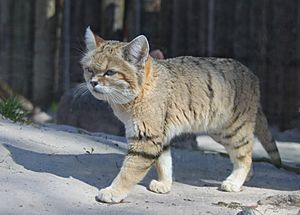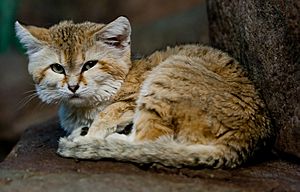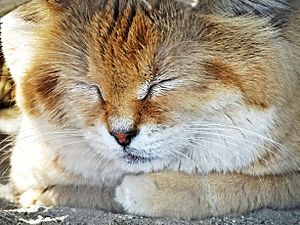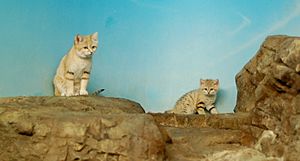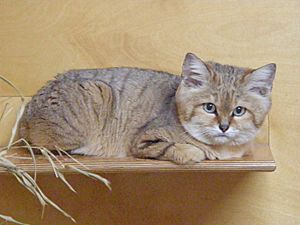Sand cat facts for kids
Quick facts for kids Sand Cat |
|
|---|---|
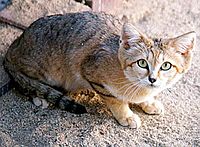 |
|
| Conservation status | |
| Scientific classification | |
| Kingdom: | |
| Phylum: | |
| Class: | |
| Order: | |
| Family: | |
| Genus: | |
| Species: |
F. margarita
|
| Binomial name | |
| Felis margarita Loche, 1858
|
|
The sand cat (Felis margarita), also called the sand dune cat, is a special type of cat that mostly lives in real deserts. This small cat can be found across the deserts of North Africa, the Middle East, and Central Asia.
For a while, starting in 2002, it was listed as near threatened on the IUCN Red List. This meant its population was small and spread out, and its numbers were going down. But in 2016, it was moved to least concern, which means it's not as endangered anymore.
Sand cats are very good at living in the desert. They have long hairs on the bottom of their feet that help them handle very hot and very cold temperatures. They live in both sandy and rocky deserts, often far from any water.
Contents
About the Sand Cat's Look
The sand cat's fur is a light, sandy, yellowish-brown color. Their markings can be different for each cat. Some have no spots or stripes, while others have faint spots or both spots and stripes. Their legs have dark brown or blackish stripes, and their tail has a black tip with two or three dark rings.
Their head is sandy brown, but their lips, chin, throat, and belly are white. Some sand cats even have a yellowish throat. They have large, greenish-yellow eyes with white rings around them. Their nose is blackish, and a light reddish line goes from the corner of each eye across their cheeks. Their whiskers are white and can be up to 8 cm (3.1 in) long.
The sand cat is a small cat with a flat, wide head, short legs, and a fairly long tail, about 23–31 cm (9.1–12.2 in). They stand about 24–36 cm (9.4–14.2 in) tall at the shoulder and weigh between 1.5–3.4 kg (3.3–7.5 lb). Their ears are 5–7 cm (2.0–2.8 in) long and set low, making their head look wide and flat.
In Central Asia, sand cats grow a very long and thick winter coat, with hairs up to 2 in (5.1 cm) long. Their front claws are short and very sharp, while their back claws are small and not as sharp. The bottoms of their paws are covered with thick fur, which protects them from extreme temperatures.
The long hairs between their toes create a soft cushion over their paw pads. This helps keep their feet cool on hot sand. It also makes their paw prints hard to see and follow.
A sand cat's outer ear looks like a domestic cat's, but its ear canal is about twice as big. This means they can hear much better than a domestic cat, especially quiet sounds.
Sand Cat Behavior
Sand cats usually live alone, except when they are looking for a mate or when a female has kittens. They communicate by using scent marks and scratch marks on things in their area, and by spraying urine.
They make loud, high-pitched, short, raspy sounds, especially when they are looking for a mate. Their sounds are similar to a domestic cat's. Sand cats have a low-pitched meow, but they can also bark to talk to each other over long distances.
They move in a special way: with their belly close to the ground, they run fast with quick jumps. They can sprint very quickly, reaching speeds of 30–40 km (19–25 mi) per hour. They bury their feces by covering them with sand.
Sand cats are usually active at night. They hunt and travel an average of 5.4 km (3.4 mi). They go underground at sunrise and stay in their burrows during the day.
Their burrows are about 1.5 m (4.9 ft) deep and are dug on slightly sloped ground, usually with only one entrance. These burrows might have been left by foxes or porcupines, or dug by gerbils or other rodents. In winter, a sand cat might stay in the sun during the day. But during the hot season, they are active at dawn and dusk (crepuscular) and at night (nocturnal).
Sand Cat Habitat
The sand cat lives in both sandy and rocky deserts. It is found widely in the deserts of North Africa, Southwest Asia, and Central Asia. It prefers flat or wavy land with not many plants. It avoids bare sand dunes because there isn't much prey there. When the weather is very extreme, it hides in burrows.
What Sand Cats Eat
Sand cats eat small rodents like gerbils and jerboas. They also eat insects, reptiles (including poisonous desert snakes), and birds. If they catch more food than they can eat right away, they bury it to save for later. They get all the water they need from their prey, but they will drink if water is available. Some Toubou people in the Ténéré Desert have said that sand cats come to their camps at night to drink fresh milk. In Israel, scientists found parts of Egyptian spiny-tailed lizards near burrows used by sand cats.
Sand Cat Reproduction
After being pregnant for 59 to 66 days, female sand cats give birth to two or three kittens. The kittens weigh 39 to 80 g (1.4 to 2.8 oz) when they are born and have spotted pale yellow or reddish fur. They grow quite fast, reaching three-quarters of their adult size within five months. They can live on their own by the end of their first year and become adults soon after. In some areas, sand cats can have two litters of kittens each year.
In zoos, sand cats can live up to 13 years. How long wild sand cats live is not yet known.
Threats to Sand Cats
Losing their natural homes is the biggest danger to sand cats. Dry desert areas are quickly being changed by people building homes and doing activities, especially by letting livestock graze. The small animals that sand cats eat need enough plants to survive. These plants can change a lot because of drought or disappear because of desertification and loss of natural plants.
Sand cats can also be killed in traps set by people living in oases. These traps are often meant for foxes and jackals, or are set because sand cats might kill chickens. In Israel, it's thought that larger predators like caracals, wolves, and domestic dogs might also be a danger to sand cats.
Sand Cats in Zoos
Sand cats in zoos are very sensitive to breathing problems and infections in their upper breathing system. This is the main reason adult sand cats in zoos die. A common disease they get is infectious rhinotracheitis. Because sand cats can easily get breathing infections, they need to be kept in very dry enclosures where the humidity and temperature don't change much.
As of May 2010, 29 sand cats were living in 12 zoos that are part of the Association of Zoos and Aquariums. These zoos are working together in a Species Survival Plan to help protect the species. In January 2010, the Al Ain Zoo announced that they successfully used a special method called in vitro fertilization and embryo transfer to have two sand cat kittens born at their facility.
Out of 228 sand cats born in zoos around the world by 2007, only 61% of the kittens lived past 30 days old. They often died because their first-time mothers didn't take care of them well enough. In July 2012, four sand cat kittens were born at the Ramat Gan Zoo as part of the European Endangered Species Programme.
Images for kids
-
Sand cat in Bristol Zoo, England
See also
 In Spanish: Gato de las arenas para niños
In Spanish: Gato de las arenas para niños



